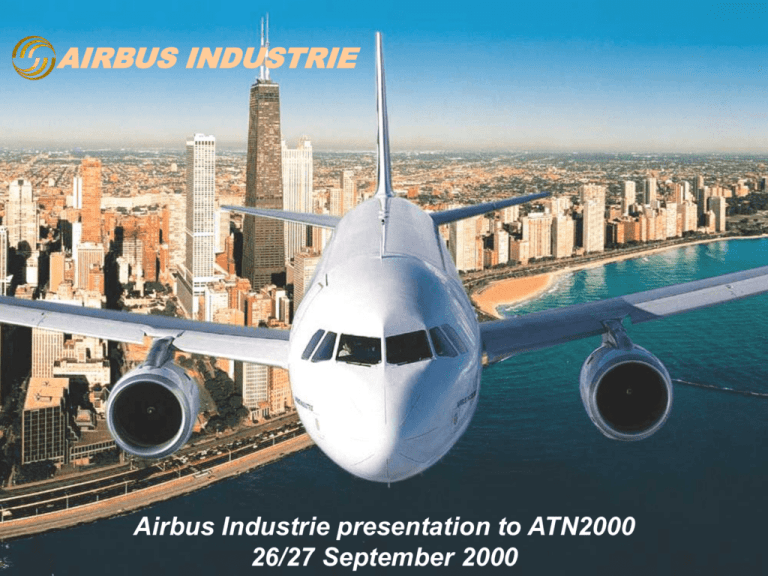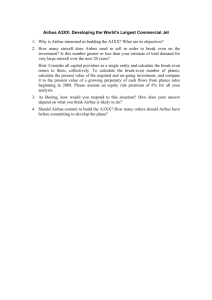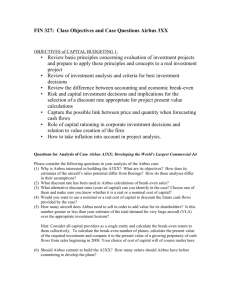
AIRBUS INDUSTRIE
Airbus Industrie presentation to ATN2000
26/27 September 2000
1
Airbus Industrie perspective
Airbus know how to build ATN, and where
the difficulties are
Airbus make available aircraft that can do it
on a massive scale (1 aircraft a day)
If we (the industry) want people to use it,
we need to give them beneficial ATM
services
Today ATN is only a cost
2
Research & Development
3
CNS/ATM R&D projects
Concept cockpit AIM FANS
• CAMELIA
• FANSTIC 1992
1996
ATN COM (Satcom VDL2) + SURV (ADS)
Operational Services (ODIAC)
• EOLIA
• ProATN 1996
2000/2001
Implementation of RRI
• CNS Project
1998
2002
• EuroVDL
2002
• TORCH
• AFAS 2000
• NUP
Validation of
VDL2 for ATC
2003
CNS/ATM
Operational
Concept
2003
4
CNS/ATM R&D projects
Concept cockpit AIM FANS
• CAMELIA
• FANSTIC 1992
1996
ATN COM (Satcom VDL2) + SURV (ADS)
Operational Services (ODIAC)
• EOLIA
• ProATN 1996
2000/2001
FANS A
Implementation of RRI
• CNS Project
1998
2002
• EuroVDL
2002
• TORCH
• AFAS 2000
• NUP
Validation of
VDL2 for ATC
2003
CNS/ATM
Operational
Concept
2003
5
CNS/ATM development strategy
Airbus R&D (methodology, concept, development,
tools) validated with FANS A certification
Experimental ATN router already in operation on
ATSU : flight and interoperability tests with ATC
stations (EOLIA/ProATN)
End-to-end communication and operational tests
performed with Air Services Australia, UK & French
ATSOs (STNA, CENA, NATS), Airsys ATM, NLR
(Dutch Laboratory)
ATN running on ATSU has flown on an aircraft. Test
bed for interoperability world wide. Interesting results.
VDL mode 2/ATN being tested
6
CNS Project
Integration of ACI/RRI in experimental ATSU in
progress
Integrated functions :
Communication : ATN, Satcom, operational services
Navigation : Integration with experimental FMS
extended functions : ATC flight plan,
integration/monitoring of CPDLC messages
Surveillance : ADS, Enhanced Surveillance (Mode S)
cockpit integration (FCU, RMP, FMS, DCDU) and
CPDLC recording
Technical validation of CNS means
7
AFAS
Aircraft in the Future Air Traffic Management System
Target : popular A320 family, runs 4/00 to 4/03
Consortium : 17 partners including major AA, ATSOs, industrial,
airline stakeholders
Based on results of previous programmes (TORCH, EOLIA,
DGPS, etc), develops the operational concepts to close the gap
between increasing demand and existing airspace capacity
Integrated CNS solution for ATM evolution (all aspects are
considered)
Supporting European evolutions (e.g. Link 2000+, RNAV in TMA,
etc.) for air/ground integration
8
Conclusion
ATN research instructive, not easy...
...but we know how to make it work.
9
Industrial Development
10
Perspective
Airbus is preparing, at UAL request, a proposal to
equip their A319/320 fleet for CPDLC Build 1A
Airbus Industrie objective is to launch SARPs
compliant DO-178B level C product (FANS B) in
4Q00
Selected router vendor for experiment is ACI
(RRI). Selection for industrial router is separate.
VDL Mode 2/AOA launched : addresses
immediate congestion, is a foundation for ATN
11
Airborne functions - the path
1999+
FANS A/1
C Arinc 622
CPDLC (DO-219)
N GPS, RNP (initial)
S ADS (DO-212)
from 2004
CNS/ATM-1
C ATN, RCP
CPDLC (ICAO)
N GNSS, RNP
S ADS (ICAO)
Future, 2008+
being defined
“Free Flight”
Global RSP (RCP / RNP
/ RMP) concept
ADS-B
CDTI
ICAO
CNS / ATM
8.33 kHz
FANS A/1
Pre-FANS
(FANS B)
VDL mode 2
AEEC 623
FANS A
HFDL
still
tbd
DGNSS
FANS B
FANS A
12
The AIM-FANS solution
Navigation Sensors
Communication Devices
AMU
ADIRS
FMS
ADF
ATSU
AOC/ATC*
including ACARS
function
Datalink
MMR
ILS/GPS
/DGPS/(MLS)
Navigation
GPS
Crew Interfaces
EFIS
ECAM
MCDU
DCDU*
Data communication
VOR
DME
Audio
VDR
Satcom
HFDR
ModeS
(ATC displays)
Printer
13
The flight crew interface
2119Z FROM KZAK CTL OPEN
AT ALCOA
CLB TO & MAINT FL310
*UNABLE
<OTHER
STBY*
ATC
COMM
WILCO*
14
Benefits of ATSU
Airbus Industrie, providing an SFE solution for
datalink, is part of a long term strategy
Involvement of the airframer is acknowledged by
airworthiness authorities
Commonality of solution
Aircraft life-long solutions
Airframer validation of systems
Desired level of interaction between systems
Is designed to fit within Airbus family concepts : glass
cockpit, dark screen philosophy, cross crew
qualification
15
FANS A certification
FANS A validation flight with JAA : 14-19 February
2000
Interoperability and transfer of centers successfully
demonstrated for AFN, ADS and CPDLC with (through
both ARINC and SITA) :
Johannesburg, Melbourne, Brisbane, Fiji, Auckland, Tahiti,
Oakland, Edmonton
HMI (DCDU) concept successfully validated
HFDL tested successfully over the pole
Airbus has proposed to ICAO to use HFDL and SATCOM
voice for ATC operations
Certification on A340 : 12 July 00
16
Lessons learned
Also successful tests with over 15 ATC centers
across the world from aircraft simulator in
Toulouse (China, Thailand, Canada, Egypt, Sri
Lanka, Eurocontrol, Australia, etc.)
Validation of Airbus test tool suite (simulator of
ATC station) representative of ATC stations
throughout the world
Similar tools are being developed for ATN.
Aircraft simulator fitted with ATSU/DCDU and
EOLIA/ProATN performed ATN tests with Air Services
Australia
17
Local tests
Ground
Processor
Test with ANETO Tools
© copyright Aerospatiale Matra Airbus 2000
18
Tests with world wide implementation
Trials with real ATC
© copyright Aerospatiale Matra Airbus 2000
19
FANS B
First product on A320 family
will meet requirements for operations such as CPDLC
Build 1A and follow on ATM services
Next step : implementation on FANS A A330/340
20
CNS/ATM standardisation activities
21
Standardisation
ICAO Panels produce Standards and
Recommended Practices (SARPs) for datalink
(VDL Mode 2, ATN, applications)
SARPs are technical standards
SARPs are global. E.g.:
CPDLC message set defined for all possible
operations (oceanic, en-route, arrival/departure, etc.)
Implementors build on ICAO standards but need
to: decide options, message sets, add their
operational requirements
=>Activities beyond ICAO standards are required
22
Standardisation & regulation
In the USA
FAA tasked RTCA with CPDLC Build I, IA definition
RTCA established Special Committee 194 (ATM Data
Link Implementation)
In Europe
Project Managements of PETAL-II and SCALA trial
LINK 2000+
JAA initiated regulatory work on AEEC623 and
ATN/Link2000+ with draft TGL (Temporary
Guidance Leaflet)
23
Europe / USA joint activities
At standardisation level:
RTCA SC-189/EUROCAE WG-53 defined ATN
Baseline 1 (CPDLC Build I, IA, PETAL-II, SCALA trial)
and is defining ATN Baseline 2 (ADLS Build II, LINK
2000+)
At implementors’ level:
FAA (CPDLC Build I, IA),
EUROCONTROL (PETAL-II) and
France (SCALA trial)
coordinate through the PETAL Integration Team (PIT)
24
However...
Differences between Europe and USA
schedule
flight phases
functions
Gap between FANS 1/A and ATN
Airframers, ATSOs, safety regulators will have to come
up with solutions to accommodate differences
The closer the operations, the safer the aircraft
Expects SARPs will need to be amended in the light of
operational implementation
25
Conclusion
The airlines and Airbus Industrie have
installed CNS enabler equipment platforms
installed many CNS functions
on a large proportion of the jet airliner fleet (1900 + 1100
aircraft, of which over 1300 in the US, adding an aircraft a
day)
with ATC benefits becoming visible, the rest will follow fast
Now it is up to the ATC service providers to provide
immediately beneficial services for airlines
with confidence in benefits, scale and schedules
With confidence in the ATC services, we can implement the
remaining functions
Thank you for listening. Any questions?
26
AIRBUS INDUSTRIE
31707 Blagnac Cedex
France
© Airbus Industrie 2000
All rights reserved.
The statements made herein do not constitute an offer. They are based on the
assumptions shown and are expressed in good faith. Where the supporting
grounds for these statements is not shown, the Company will be pleased to
explain the basis thereof.
This document is the property of Airbus Industrie and is supplied on the
express condition that it is to be treated as confidential. No use or reproduction
may be made thereof other than that expressly authorized.
27
Glossary
ACARS
ACARS MU
ACAS
ACMS
ACP
ADF
ADIRS
ADS
ADS-B
AECMA
AFN
AFS
AIDS
AIM-FANS
AOC
AOA
AIRSAW
AMP
AMU
ANP
AOA
AOC
ARINC
ASAS
ASP
ATC
ATM
ATN
ATS
ATSU
AVLC
BDS
BFE
BRNAV
Aircraft Comm, Addressing and Reporting System CBA
ACARS Management Unit
CDTI
Airborne Collision Avoidance System
CFDIU
Aircraft Condition Monitoring System
CMA
Actual Communication Performance
CMC
Automatic Direction Finder
CNS
Air Data Inertial Reference System
CNS/ATM
Automatic Dependent Surveillance
CPDLC
ADS-Broadcast
CT
Association Euro. Des Constructeurs de Materiel Aero.
DA
ATC Facilities Notification
DCDU
Auto Flight System
DGNSS
Aircraft Integrated Data System
DMC
Airbus Interoperable Modular FANS
DME
Aeronautical Operational Communication
ECAM
ACARS over AVLC
EFIS
Airborne Situational Awareness
EIS
Actual Monitoring Performance
EWD
Audio Management Unit
FAA
Actual Navigation Performance
FANS
AVPAC Over ACARS
FCU
Airline Operational Communication
FF, FV, FP, CF
Aeronautical Radio Inc.
FG
Airborne Separation Assurance System
FIS
Actual System Performance
FLS
Air Traffic Control
FMS
Air Traffic Management
FWC
Aeronautical Telecommunication Network
GBAS
Air Traffic Services
GCAS
Air Traffic Services Unit
GLS
Aviation VHF Link Control
GNSS
Comm-B Designated Subfield
GPS
Buyer Furnished Equipment
GPWS
Basic Area Navigation
HF(HFDR)
Cost Benefit Analysis
Cockpit Display of Traffic Information
Centralized Fault Display Interface Unit
Context Management Application
Central Maintenance Computer
Communication, Navigation and Surveillance
CNS / Air Traffic Management
Controller-Pilot DataLink Communication
Cabin Terminal
Decision Altitude
Data Communication Display Unit
Differential GNSS
Display Management Computer (EFIS/ECAM)
Distance Measuring Equipment
Electronic Centralized Aircraft Monitoring
Electronic Flight Instrument System
Electronic Instrument System
Engine & Warning Display
Federal Aviation Administration
Future Air Navigation System - see CNS/ATM
Flight Control Unit
FMS waypoints naming convention
Flight Guidance
Flight Information Services
FMS Landing System
Flight Management System
Flight Warning Computer
Ground Based Augmentation System
Ground Collision avoidance System
GPS Landing System
Global Navigation Satellite System
Global Positioning System
Ground Proximity Warning System
High Frequency (Data Radio)
Glossary
HFDL
HMI
ICAO
ILS
ISPACG
LAAS
LADGPS
LCD
LR
MCDU
MLS
MMR
MSAW
OSI
RCP
RD
RFC
RMO
RMP
RNav
RNP
RSP
RTA
RVSM
SA
SARPs
Satcom
Satnav
SBAS
SDAC
SDU
SFE
SMGCS
SSR
STC
Supplemental Type Certificate
High Frequency DataLink
STCA
Short Term Conflict Alert
Human Machine Interface
STDMA
Self organizing Time Division Multiple Access (VHF)
International Civil Aviation Organization
TAWS
Terrain Avoidance Warning System
Instrument Landing System
Traffic Collision Avoidance System
Informal South Pacific Atc Coordination Group TCAS
TIS
Traffic Information Service
Local Area Augmentation System
VDL
VHF Data Link
Local Area Differential GPS
VHF (VDR)
Very High Frequency (VHF Data Radio)
Liquid Crystal Display
VOR
VHF Omni-directional Range
Long Range (A330/340 family)
WAAS
Wide Area Augmentation System
Multipurpose Control and Display Unit
WB
Wide Body (A300/310 family)
Microwave Landing System
XPDR Mode S Transponder Mode Selected
Multi-Mode Receiver
Minimum Safety Altitude Warning
Open System Interconnection
Required Communication Performance
Research & Development
Request For Change
Retrofit Modification Order
Radio Management Panel/Required Monitoring Perfo.
aRea Navigation
Required Navigation Performance
Required Systems Performance
Required Time of Arrival
Reduced Vertical Separation Minima
Single Aisle (A318/319/320/321 family)
ICAO Standard And Recommended Practices
Satellite Communication
Satellite Navigation
Satellite Based Augmentation System
System Data Acquisition Concentrator
Satellite Data Unit
Supplier Furnished Equipment
Surface Movement Guidance and Control System
Secondary Surveillance Radar








